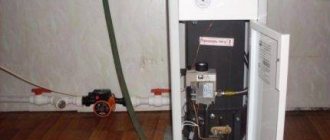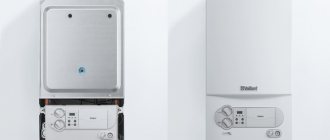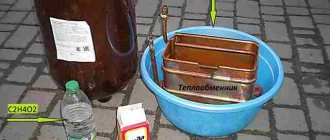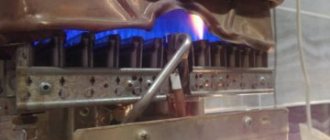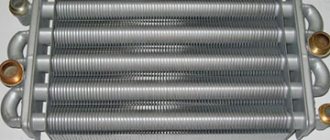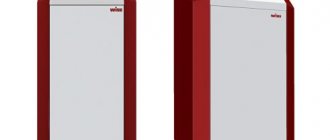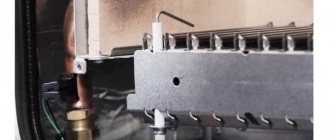Lemax gas boilers seriously compete with their European counterparts.
They are assembled from spare parts manufactured by recognized leaders in the production of heating equipment - Vaillant, Sit and other well-known manufacturers.
With excellent quality, the cost of Lemax boilers is two or more times lower than that of the “Europeans”.
Basically, this is achieved by eliminating all additional devices and components from the design, leaving only the most necessary elements.
This has a positive effect on the performance of the units, reduces the frequency of breakdowns or failures, but some malfunctions still occur.
Main malfunctions of Lemax gas boilers
The most common malfunctions include:
- Gas leak. Immediately open the windows, turn off the gas supply, turn off the boiler and call the gas service workers.
- The color of the flame is reddish, the tongues are elongated and smoke. Weak draft or burner clogging. Clean the chimney and burner, correct the position of the pipe.
- Spontaneous shutdown of the main burner. Problems with the chimney or thermostat.
- There is no water circulation. If there is a pump, the reason lies there. If natural circulation is used, it is necessary to correct the configuration of the pipelines, giving them the correct slope.
- Boiler shutdown. Usually occurs due to a gas supply interruption.
The list of possible malfunctions can be continued for a long time, but there is no point in this, since each situation requires separate consideration.
Possible breakdowns and their repair
The devices have a fairly simple design, so if you have minimal skills, you can try to fix the problem yourself. To figure out why the Lemax gas boiler goes out and deal with the malfunction, you must first turn off the gas supply, turn off the device and let it cool completely.
Failure 1: The thermocouple has failed
This is one of the main reasons why the Lemax gas boiler turns off. A thermocouple is a sensor that monitors the presence of a flame. In its absence, the gas is automatically shut off.
Before starting work, the thermocouple is warmed up so that the valve remains in the open position. But sometimes the security system blocks it by mistake. This happens in the following cases:
- The flame does not reach the sensor. For more information about this malfunction, using the example of another manufacturer, see the video below?
- the copper tube transmitting signals burned out;
- soot and dirt have accumulated on the sensor;
- The thermocouple is not screwed into the adapter well.
First, find the part. It is a copper tube, the first end is connected to the control unit, the second - to the panel near the igniter.
First try to tighten the fastening nut. If it's a bad connection, this will work. Also unscrew the bottom of the element. Check the sensor and if it needs cleaning, carefully remove any soot or dirt with a cloth. Return the nut to its place and try to start the Lemax gas boiler.
If nothing has changed, check to see if there is a flame at the end of the thermocouple. It can be bent by unscrewing the panel. Also, try adjusting the burner heat.
You can check whether the part works using a multimeter. You will need to unscrew both parts of the thermocouple. At the end in contact with the automatic block there is a tip with which a signal is transmitted to the valve. Clean the element thoroughly.
Place the sensor in such a way that it heats up (for example, from a stove burner). Connect the multimeter to the tip and also to the copper tube, then measure the voltage. A malfunction in the thermocouple itself indicates that you have to buy a new element.
Failure 2: traction sensor does not work correctly
This part automatically shuts off the gas when combustion products are poorly removed from the room. Faults in it can also be the reason why the wick in a Lemax gas boiler goes out.
One of the breakdowns may be a faulty overheat sensor. The element fails infrequently, but contacts and wires sometimes fail. They need to be cleaned with a thick cloth. You can use alcohol or solvent.
Check the integrity of the wires, and do not forget to dry the cleaned contacts before starting. Put them back, trying to insert them as tightly as possible. Check the operation of the equipment.
If the device does not work, close the contacts on the adapter to the valve using a wire. In a situation where the problem is in the draft sensor, the boiler will start. Immediately return everything as it was. Call a specialist to replace the part or do it yourself.
Failure 3: nozzle clogged
If the Lemax gas boiler does not ignite at all, and you do not even hear the characteristic hiss of gas, this often indicates a clogged nozzle.
Disconnect the tube that goes from the control unit to the pilot burner. The nozzle through which the gas moves is either attached to this tube or is a separate element. Use a toothpick to clean the inlet and blow into it to remove the blockage.
Unscrew the 2 screws on the panel where the tube was attached. There is a mesh through which air is captured. If there is dust or fur on it, blow it gently.
How to disassemble a gas boiler, see the video below?
Collect all the parts and start the equipment. When turned on, a characteristic hissing sound should appear.
Failure 4: problems with piezo ignition
This is a device that allows you to ignite a Lemax gas boiler by simply pressing a button. The pulse forms a spark that ignites the gas.
If an element fails, you need to find the exact location of the failure. Pull out all the wires from the spark plug located next to the igniter, press the start button. If a clicking sound appears, the electrode is faulty. If there is no click, the block under the button is broken. You may need to purchase a new part to replace the broken one.
Failure 5: gas valve faulty
With the help of a valve, gas is supplied to the burners, and in the event of an emergency, the resource supply is stopped. This is a complex device element that consists of several components. It is better not to try to fix it yourself, unless you have experience in repairing and troubleshooting a Lemax gas boiler.
To gain access to the part, you need to unscrew the adapter with the thermocouple, and also unscrew the element itself. It is attached tightly, so difficulties may arise.
It is better to entrust the inspection of the equipment to a specialist. Sometimes the valve will need to be replaced, but sometimes an adjustment will do.
The most common errors of the Lemax boiler include clogging of the nozzles or chimney. Problems with device parts occur less frequently. You can try to independently determine and eliminate the cause of the malfunction, or entrust this to a specialist.
Why does the device go out?
There may be several reasons why the burner goes out:
- Stopping the gas supply. Turn off the boiler and wait until the supply is restored.
- Unstable or absent voltage in the power supply network (for volatile Lemax boilers).
- Failure or activation of the traction sensor. We need to check whether it is there and whether the chimney is clogged. Sometimes cleaning the sensor contacts helps.
- The thermocouple contacts have oxidized and do not close. It should be cleaned with fine-grained sandpaper.
- Reverse, insufficient or excessive draft. The draft sensor responds to all situations by turning off the burner.
Problems with traction are most common in non-volatile installations, where the stability of the unit’s operation depends on it.
If the draft is too weak, the sensor turns off the burner due to the possibility of smoke in the room.
Excessive draft is dangerous due to the possibility of the flame on the burner exploding, which will provoke the supply of gas into the room with unpredictable consequences. Therefore, an increase in draft against the set value is also an emergency event, leading to the boiler stopping.
What you can do yourself
The sequence of first actions is the same in all cases:
- The boiler is disconnected from the power supply, and the gas tap is completely closed.
- A visual inspection is carried out to check for possible blockages and mechanical damage.
- If the combustion chamber is open, you can simply light a match or lighter and hold the flame near the holes through which air is supplied to the burner. If the draft is not clogged, the tongue will immediately deflect towards the holes, and the flame will burn evenly. If the flame deflects weakly, then there are large blockages.
- You can also draw conclusions based on the operation of the boiler. If it hums quite loudly, and the color of the flame is closer to colorless, then the draft is too strong - it needs to be reduced.
Similar problems can arise at the very beginning of the boiler operation - in case of improper installation, with deviations from the diagram presented below.
How to turn on (light)
The Lemax boiler is started after filling the system with the required volume of water (12-14 liters for each kW of power) and connecting the gas pipeline.
Procedure:
- Open the lid, providing yourself with access to the regulator and the piezo ignition button.
- Turn the regulator counterclockwise, which will move the boiler to the “on” position.
- Push the regulator all the way in and hold it in this position while simultaneously pressing the piezo ignition button.
- After a flame appears on the pilot burner, the button can be released, but the regulator must be held for about another minute.
IMPORTANT!
If an attempt to ignite the boiler was unsuccessful, it can be repeated only after 1 minute, not earlier.
Clogged nozzles or burner filters
These components are starting ones. And if, when you turn on the device, the pilot light does not ignite, it means that blockages have formed in them.
The following parts need to be cleaned:
- ignition nozzle,
- input filter with small cells in a mesh,
- burner filter.
Handy tools help in the work. For example, filters can be easily blown out with a vacuum cleaner.
The injectors are cleaned carefully with a thin copper wire. The process continues until the jets reach their original diameter.
Doesn't start (ignite)
The unit is ignited according to a certain pattern. It does not always start the first time, and this is quite normal. But, if after repeated attempts the boiler does not ignite, it is necessary to check the condition of the components responsible for ignition.
Possible reasons could be:
- Failure of the electronic or mechanical ignition system. It is necessary to replace the system, or clean the thermocouple contacts.
- There is no voltage in the power supply network (for volatile units).
- The valve on the gas supply pipe is closed.
- The gas pressure in the system does not correspond to the nominal values.
- The main burner nozzles are clogged. It is necessary to clean them and start the boiler.
All these reasons are the most common, but far from the only possible ones. Any malfunction in the system can negatively affect the ignition of the boiler .
NOTE!
If you have tried all the options, but the problem is not solved, you need to call a technician from a service organization.
This is important to remember
Gas devices are classified as high-risk equipment. Therefore, the main thing to do in case of a problem is:
- turn off the boiler;
- check if there is gas contamination in the room;
- ventilate the room.
Only after this can you figure out what to do if the gas boiler does not light.
After this, the main thing is to check the traction, and then study the error code on the display. This will help you understand whether you are able to fix the problem yourself or whether you will have to call a technician.
So, if the boiler does not ignite or if its flame is very weak and goes out after a while, then this may mainly be due to mechanical reasons (clogging). And such malfunctions can be eliminated yourself.
If the reason is different (or it cannot be determined reliably), it is preferable to contact a gas equipment servicing company to call a technician.
Why is blood pressure rising?
Increased pressure is a serious and dangerous situation. An increase in pressure in the system can only mean an increase in the amount of water.
This occurs due to the expansion of the coolant when heated. Any liquid is incompressible, so an increase in its volume can lead to rupture of the heat exchanger, or, in the most serious case, provoke an explosion.
To eliminate this possibility, an expansion tank is used in the design of boilers. It absorbs excess water volume, compensating for its increase when heated .
An increase in pressure most often indicates a problem with the expansion tank. Its design consists of a container and an elastic membrane installed approximately in the middle.
When the liquid begins to flow, the membrane sag and makes room for excess water..
When the volume decreases, it returns to its previous position. If the membrane is torn or not firmly attached to the expansion tank stacks, the coolant will fill the entire volume of the tank.
When expanding, the water will have nowhere to go, which will provoke a constant increase in pressure. The solution to the problem is to restore the condition of the membrane or replace the expansion tank with another, serviceable copy .
Electrical problems
When the solenoid valve (EMV) does not make good contact with the thermocouple, there is incorrect information about the absence of a flame. This causes the fuel supply to be blocked.
For this reason, the gas boiler lights up and goes out after a short time or when selecting options.
This is a sign of a problem in the electrical circuit:
- The thermostat and thermocouple or vacuum indicator are not in contact.
- The thermocouple is outside the flame or does not provide the required voltage.
- The marked parts and the EMC coil are broken.
These difficulties can be eliminated with your own hands by strictly following this algorithm:
- Consistent resistance testing on indicators and contact devices. Indicators of 0.3 - 0.5 Ohm are considered normal.
- Cleaning all oxidized areas with fine sandpaper. Tightening loose contacts.
- Disconnecting the thermocouple from the main unit. Connecting the tester. Turning on the pilot burner by pressing the release button.
- Voltage measurement. Standardized values: 10 – 50 mV.
If the readings are normal, adjust the thermocouple position. If there is no voltage, the following measures are needed:
- remove the top cover of the main unit,
- The thermocouple is heated using a torch,
- Pressure is applied to the safety valve, after which it is released.
If the thermocouple does not work correctly, the wire contacts are checked.
If after pressure and release the valve is static, you need to remove the complex with contacts and direct 220 V voltage to the coil, bypassing the thermostat.
Then the boiler starts. If problems persist, it is necessary to change the EMC coil and thermocouple.
What causes blood pressure to drop?
A drop in pressure (the boiler goes out) indicates the appearance of leaks. It is necessary to check the condition of pipelines, threaded connections, gaskets and other external elements of the heating system . If there is no visible damage, you should look for problems with the boiler.
The main problem element may be the heat exchanger. Welded joints sometimes crack or break due to frequent temperature changes. Sectional cast iron heat exchangers used on powerful floor-standing models are risk factors at section connections.
In addition, the pressure relief valve may be triggered or jammed open..
Threaded connections of pipes can also lose their tightness due to drying out or destruction of gaskets, non-threaded connections, etc. All detected problems are eliminated in accordance with their specifics.
Oxygen deficiency
This phenomenon is usually caused by poor ventilation. It is determined by the following factors:
- window sealing,
- interior doors equipped with dense insulation and no gaps,
- a kitchen hood that is too powerful,
- unnatural ventilation.
The boiler may go out due to a powerful kitchen hood directing air through its channel.
The solution to the dilemma lies in installing supply valves on windows and walls. In the second case, ventilation devices are installed. They forcefully draw in air from the street.
Connecting a room thermostat
A room thermostat is a convenient and useful device that allows you to regulate the temperature of the air, not the coolant, in the heating system. The default sensor monitors the outlet temperature of the heating agent.
This does not give a correct picture of the state of the microclimate in the room. For example, when the outside temperature rises, the room becomes hot .
But the sensor cannot track this, and the extract air temperature is within the limits specified by the mode, so from the point of view of the system, everything goes fine, in accordance with the boiler settings.
If a room thermostat is used, the burner will turn off much earlier, which will improve the microclimate in the room and significantly reduce gas consumption.
To connect the room thermostat, you need to set the boiler's own element to the maximum temperature.
It will only work as an overheat limiter . The external unit is connected at one end to the automation unit, and at the other to the boiler thermostat. By default, a jumper is installed between the contacts, which must be removed and the thermostat connected.
IMPORTANT!
It is necessary to use the appropriate brands, for example - CEWAL RQ10. Installation of a thermostat is only possible on boilers marked N (with the SIT 820 NOVA automation unit).
Reasons for clocking
Clocking indicates the frequency of switching on of the device that provides heating of the thermal fluid. In the absence of external control devices connected to the equipment, most often the time interval between turning on the boiler does not exceed 10 minutes, and by default such indicators are only three minutes. Frequent switching on and off is not a recommended mode for operating a gas boiler.
In order to maximize the economical consumption of blue fuel, it is advisable to choose the option of continuous operation of equipment with compensation for heat losses. Among the main problems that provoke the clocking of the unit, the following can be noted:
- overheating of the device under high power conditions;
- insufficient gas supply pressure;
- incorrect installation of the thermostat;
- various pump breakdowns;
- filter clogging.
In small rooms, excessive gas consumption is common, so when choosing equipment it is very important to correctly calculate its technical indicators and basic operational characteristics. Among other things, the configuration parameters of different models often differ significantly, which requires a mandatory and very careful study of the instructions before configuring the equipment
Let's look at the main reasons for the boiler constantly turning on and off.
Common problems with turbocharged models
The indicated difficulties also arise in turbocharged vehicles. And since this technique has an isolated combustion compartment and additional components, it is characterized by the following difficulties:
- The hood or coaxial chimney is covered with ice.
- The integrated air blower is broken.
The culprits of the first problem are accumulated condensation and adhered snow.
You can avoid it by protecting the chimney from aggressive factors - installing a deflector.
If ice plugs have already formed, they can be melted with a hairdryer or a torch - a spray can.
As a rule, condensate settles in pipes of convection modifications, for example Lemax PRIME-V10.
Traffic jams form here due to temperature differences in air flows coming from the street and heading outside. They block the path to the combustion compartment.
The solution lies in lighting the chimney with a portable burner. When you remove the plug, insulate the pipes.
If the boiler has a built-in blower, as in the Baxi ECO-4s 24 model, and it goes out during operation or the wick does not start immediately, pay attention to the sounds that appear.
With stable functions there are measured beeps. Excessive noise is a sign of a problem.
Turbocharging, as a rule, is not repaired, but quickly replaced.
If there are no sounds when the device is operating, it means that the automatic mechanism is preventing the safety valve from opening and the filter does not ignite.
Call specialists to replace the turbocharger. Because this work is quite complex and associated with a certain risk.
Situations with dual-circuit devices
This technique may fade due to the reasons mentioned above. But if none of the signs are suitable, then the difficulties are caused by the specifics of the boiler. This category includes the response of the protective system against water overheating.
Documents for devices with separate heat exchangers, for example Ariston Clas B Evo 24 FF, usually indicate prohibitions on the simultaneous opening of two taps.
And in the settings, the optimal temperature for heating water is initially selected. To do this, use the regulator on the control console. Example on the Navien Ace device:
It should be taken into account that when cold water is turned on, the consumption of hot water is reduced and heat is generated in an identical mode. As a result, the heat exchanger overheats. Then the automation reacts, shuts off the gas, and turns off the boiler.
If you operate the device strictly according to the instructions, but it still goes out, the gasket of the water mechanism must be changed. There is a high probability of it wearing out.
All identified problems can be avoided if you carefully monitor the boiler’s condition and regularly arrange its technical inspection.
If you find it difficult to identify the cause, or there is already a noticeable smell of gas in the room, call the experts immediately.
